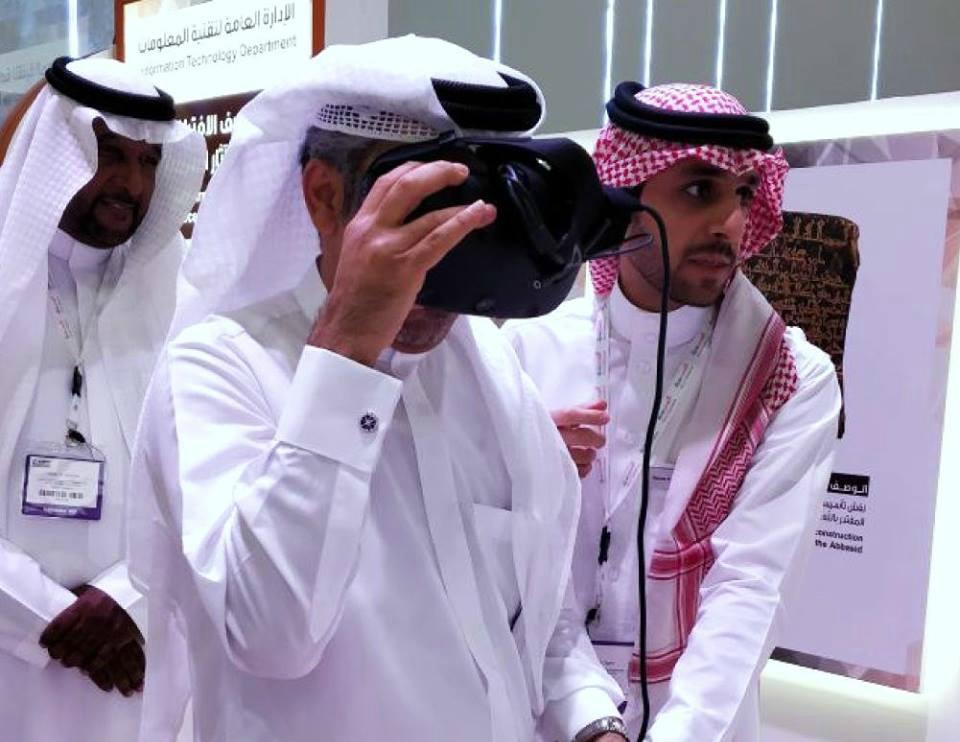Viewing ancient artifacts in the newest ways: Saudi relics travel with Snapchat, augmented and virtual reality
Photo: A visitor puts on virtual reality (VR) glasses at the Saudi Commission for Tourism & National Heritage museum wing at the Arabian Travel Market 2018 in Dubai, UAE. Photo supplied by Saudi Commission for Tourism & National Heritage (SCTH)Â
Saudi archaeological relics dating back to more than a million years are now accessible to people around the world thanks to the use of new technology by the country’s tourism and heritage authority.
The collection is part of a traveling exhibition that showcases artifacts and historical objects discovered in excavation sites across the kingdom. It has so far been hosted by 13 international museums in Europe, the U.S. and Asia, with the U.S. alone hosting the exhibition five times.
“This is a traveling museum that consists of 466 rare archaeological pieces all found in the kingdom,†Hisham Al Garni, projects planning section head of the Information Technology Department at the Saudi Commission for Tourism & National Heritage (SCTH) told Salaam Gateway.
A joint initiative of Saudi Aramco’s King Abdulaziz Center for World Culture and SCTH, the exhibition is helping to change the stereotypical image of Saudi Arabia, showing that there’s much more to the kingdom than oil, and introducing its cultural and historical dimensions, as Youngjae Kim, spokesperson at the Embassy of Korea in Riyadh highlighted during the exhibition’s stop in Seoul in 2017.
For those who cannot visit the traveling exhibition in person, SCTH has created a book containing 3D images of the archaeological treasures.
Anyone who takes a copy of this 68-page book from the exhibition and downloads the Road of Arabia Augmented Reality (AR) app, can view the artifacts via an AR effect on all the objects, rotating the 3D models and zooming in on them.
SCTH has also developed a virtual reality (VR) technology to enable visitors to industry and trade shows to see inside the Saudi Archaeological Masterpieces museum and look closely at the antiquities.
To reach a wider, and younger, audience, the Commission has also integrated the relics into social media use.
“We have also developed a feature on Snapchat that allows you to scan a 3D model of an archaeological masterpiece and keep it with you for 24 hours. Wherever you are in the world, you can take a selfie with that object in the background – an archaeological piece that dates to nearly 8,000 years BCE,†said Al Garni.
FROM PRE-ISLAM ARABIA TILL TODAY
The pieces span historical periods, starting from the Paleolithic Period (Stone Age), to the late Arab kingdoms, early Islam, the Umayyad, Abbasid, the middle and late Islamic periods, up to the unification of Saudi Arabia and the progress made from then onwards.
From tools, pottery and jewellery, to sculptures and incense burners, the objects have been selected from various locations, including the National Museum of Riyadh and King Saud University Museum as well as recent excavations.
One of the most fascinating objects is a statue of a horse that the Saudis say show the animal was domesticated 9,000 years ago in the Arabian Peninsula. The discovery challenged the theory that domestication of the horse took place 5,500 years ago in Central Asia, said Ali al-Ghabban, vice president of antiquities and museums at the Saudi Commission for Tourism and Antiquities during the statue’s discovery in 2011.
TRAVELING THE WORLD
“Countries around the world make special requests to host us and we usually stay for a few months. The USA recently invited us again,†Al Garni said.
The traveling exhibition started in 2010 when it launched at the Louvre Museum in Paris. Since then it has traveled to La Caixa Foundation in Barcelona, Spain, the Hermitage Museum of Art & Culture in Saint Petersburg, Russia, the Pergamon Museum in Berlin, Germany, and the Vittoriano Museum in Rome, Italy, before it moved to the U.S.
In the U.S. it was first hosted by the Arthur M. Sackler Gallery and Freer Gallery of Art in Washington, DC, followed by the Carnegie Museum of Pittsburg in Pennsylvania, the Museum of Fine Arts in Houston, Texas, the Nelson Atkins Museum of Art in Kansas City, Missouri and finally, by the Asian Arts Museum in San Francisco, California.
The Asian Arts Museum was the exhibition’s fifth and final stop in the U.S. before it went on an Asian tour of national museums in Beijing in 2016, Seoul in 2017, and Tokyo in January 2018, where it will stay until November.
Just after Seoul and before moving to Tokyo, the expo returned to Riyadh for the first edition of the Saudi Archaeology Convention. The three-day event, held in November 2017, focused on archaeology and scientific projects and raising awareness of national monuments among Saudi citizens.
“Many international museums are now competing to host the exhibition. This proves the value of our archaeological pieces that date back to thousands of years, and the importance of Saudi Arabia’s history and ancient civilizations,†said Al Garni.
(Reporting by Heba Hashem; Editing by Emmy Abdul Alim [email protected])
Our Standards: The Thomson Reuters Trust Principles
© SalaamGateway.com 2018 All Rights Reserved
